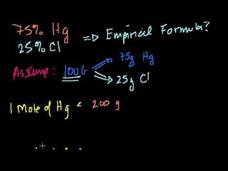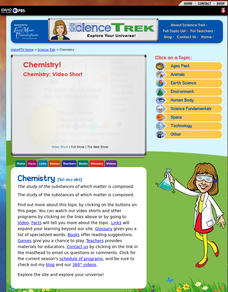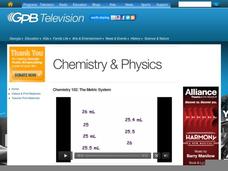TED-Ed
Periodic Videos
From hydrogen to ununoctium, this collection of videos has everything you need to begin teaching about the periodic table. Offering descriptions of each element and interesting experiments demonstrating their properties, this resource is...
American Chemical Society
The Four "New" Elements and How We Got Them
How are new elements created? Are they really new? Journey to the end of the periodic table with a video from the American Chemical Society's Reactions playlist. The narrator describes the conditions under which new elements are formed...
Education Development Center
TV 411 What's Cooking? Salt
Here is a recipe for a practical cross-curricular lesson! Cover unit conversions and ratios for math, the periodic table of elements for science, the difference between sodium and salt and its relation to high blood pressure for...
Curated OER
Electricity and Matter Part 4 - Atoms and Elements
Consisting entirely of photos and simple graphics, this fundamental video is an informative presentation. Topics include elements, molecules, chemical bonds, atomic mass, isotopes, and ionization. Because it covers a wide range, it would...
Socratica
Chemistry: Average Atomic Mass (AMU, Daltons, etc.)
Scientists created a new measurement, the atomic mass unit, which is defined as carbon 12 = 12amu. So why isn't carbon listed as having exactly 12 amu on the periodic table? An installment from the Socratica chemistry playlist answers...
SciShow
Helium
The helium in a balloon comes from the radioactive decay of the elements thorium and uranium. Video two in this series of 48 explores the element helium. The narrator discusses how humans use it, where it is found, how the United States...
Mystery of Matter
Into the Atom, Part 2: The Atom’s First Pieces
Could electrons really be as small as the numbers suggest? This is the hurdle for the initial study of electrical properties of elements. Learners view a video to follow the history of the science that led to the discovery of the parts...
Periodic Videos
Strontium
Strontium, named after the Scottish town of Strontian, finds itself as the only element named after a location in the United Kingdom. Learn more about this metal element by watching the 38th installment in a larger series of 118 videos....
Periodic Videos
Copper
In the United Kingdom, the amount of copper in wiring and piping works out to around 175 kilos per person. The 29th video in a series of 118 on chemical elements highlights copper. It discusses the properties, applications, and fun facts...
Curated OER
Formula from Mass Composition
Students of chemistry are shown how to calculate the empirical formula from a molecule's mass composition. Sal uses a variety of elements from the Periodic Table to demonstrate the process and the calculations involved to arrive at the...
Periodic Videos
Helium (Version 1)
Helium is the second most common element in the universe, yet we are running out of helium on Earth. A video on this important element includes common reactions, uses, and concerns that scholars need to know to understand helium.
Curated OER
The Mole and Avogadro's Number
Sal introduces chemistry students to the concept of "moles." He points out that a mole is number that helps a student to translate between grams and atomic mass units of any substance. Sal uses the element Aluminum to illustrate this...
PBS
Science Fundamentals: Chemistry!
Chemical reactions are a part of almost everything in everyday life. A video presentation gives an introduction to chemistry by describing the basics of atomic structure and chemical reactions. Learners discover chemical reactions are...
Educreations
Lewis Dot Structures
What may look like a bunch of dots is actually complex science! Gilbert Lewis' work is important for understanding molecular chemistry, and his approach is great for visual learners. The video describes the process of drawing a Lewis dot...
GPB Television
Chemistry 102: The Metric System
Although this lesson is directed at a chemistry class, all laboratory classes require the use of metric measurement. Here is a half-hour video introduction to measurement systems and a thorough teaching about the base-ten metric system...
GPB Television
Chemistry 203: Separation of Mixtures
Do not pass this resource by! Everything you need to teach the property of density,and the separation of mixtures is here: an educational video, several classroom handouts, and a laboratory exercise. The video is engaging, though a...
GPB Television
Chemistry 502: The World of Atoms is Not Enough – Bonding Part II
"The name is Bond. James Bond." Or is that "Chemical Bond?" Assign the viewing of the video as homework, and then have your chemists come to class to practice drawing electron dot diagrams and Lewis structures with the several bonus...


















